1970 Nissan Fairlady Z432R

Forget what you know about the current Nissan 370Z. It’s totally forgettable and seriously overdue for a redesign. The Fairlady Z in the form of the Z432 that only sold in Japan is the Z-Car…

Forget what you know about the current Nissan 370Z. It’s totally forgettable and seriously overdue for a redesign. The Fairlady Z in the form of the Z432 that only sold in Japan is the Z-Car…
If you can’t afford to get your hands on a Nissan GT-R Nismo but have always wanted to own one, here’s your chance. The automaker is partnering for the first time with Lego Group to debut a Lego version of the GT-R Nismo supercar, set to debut in stores globally in January.
It’s the first-ever partnership between Lego and a Japanese carmaker, and it’s one of the first offerings in the 2020 Speed Champions-themed sets, which currently feature everything from a 2018 Dodge Challenger SRT Demon to a McLaren Senna. The 2020 Speed Champion models will also grow 25% larger than previous-year versions.
Helpfully, Nissan provided some specs comparing the 2020 GT-R Nismo, which is celebrating its 50th anniversary this year, and its Lego version. Chiefly, the former took more than 10 years of development time and is assembled from more than 90,000 parts, while its plastic-block version took roughly a year to develop and comes in 298 parts. It takes a normal builder about an hour to put it together, while an expert Lego builder can have a finished supercar in about 20 minutes.
Lego said the GT-R Nismo was at the top of its wish list for racing and drift car recreations, and it spent a lot of time devising different building techniques, especially to recreate the car’s iconic taillights. It leaves us wondering which highly buzzed-about Japanese sports car might be next. Toyota Supra, mayhaps?
Nissan unveiled the 2020 version of the GT-R Nismo earlier this year at the New York Auto Show, showing a car that wears a lot of carbon fiber, new front fender vents and a 20% improvement in acceleration response, among other changes.

Nissan’s new Skyline is equipped with various driving assistants, route-driving, high-precision map data and the ability to overtake, branch and take exits–a technology they called ProPilot 2.0. In order to show off what the technology…
Table of Contents
Celebrating its 50th anniversary last year, the GT-R moniker has had an undoubtedly storied past. The current iteration of the GT-R, known as the R35, has produced another fine chapter in book of automotive legend. The latest apogee in this ongoing tale is the impending release of the 2020 Nissan GT-R Nismo, which was unveiled at last year’s New York International Auto Show.
Now entering the 11th year of this golden generation, the R35 has seized the opportunity to become a household name in mainstream motorsport stardom. With that being said, the achievement of so many milestones is also revealing in how long it has been in the scene.
Therefore, it would be serendipitous if this latest GT-R Nismo also drew the curtains on the R35, ushering an era of fresh ideas, and ultimately the next generation of the GT-R.
The 2020 Nissan GT-R Nismo is the first production-spec GT-R to benefit from sharing parts directly from the GT-R GT3 race car. In summary, the new GT-R Nismo is lighter, more responsive, has better aerodynamics, is more efficient at cooling and brakes greater than ever.
What this should inevitably translate to – likely in the near future, as the release date approaches – is the fastest lap time set by a factory assembled and street-legal GT-R at the Nürburgring.
Each of the changes on their own isn’t particularly notable compared to the 2019 Nissan GT-R Nismo. Both cars look mostly the same, with a keen eye required to spot the changes – such as the vented front fenders, redesigned wheels, lighter-weight exterior components, bigger brakes, and beefier tires.
In fact, overall power figures for the 2020 car remain unchanged; the key difference is that this newest version utilizes the same turbocharger hardware used in its GT3 version, which Nissan claims will significantly improve engine response and acceleration.
Over the past 10 years, the Nissan GT-R has been the subject of perpetual tweaking, refining, and perfecting. The 2020 Nissan GT-R Nismo is the culmination of a decade’s worth of experience, knowledge, and mastery of one’s craft.
It is Nissan’s interpretation of what the quintessential modern supercar needs to be – the perfect balance of refinement for the road and performance for the track. I have no doubt that the latest Nismo will be the most complete representation of this philosophy that we have seen.
Specifications:
The 2020 Nissan GT-R Nismo employs the same 3.8L twin-turbocharged V6 that has continued to evolve over the life-cycle of the R35. Since its inception, the VR38DETT power plant has undergone numerous stages of updates which have made it more powerful than the version before – the new Nismo is no exception, as the most powerful and advanced version to come out of the Tochigi assembly plant.
Producing 600-horsepower @ 6,800 rpm and 481 ft-lb of torque @ 3,600 rpm, overall output remains unchanged compared to the 2019 Nissan GT-R Nismo – but that’s just on paper. Where it really matters is in the exclusive turbocharger design which is borrowed directly from the GT-R GT3 race car.
The modified turbine architecture further optimizes flow rates and improves acceleration response by 20% thanks to quicker spooling, even under the same level of boost pressure. A new titanium exhaust provides the finishing touch, enhancing the car with a more pronounced growl and a bit of weight reduction.
Mated to the engine is a revised version of the evergreen 6-speed dual-clutch transmission, which continues to send power through car’s legendary all-wheel-drive system. It now features a smarter ‘R mode’ which allows for lightning-quick and smoother gear shifts.
The adaptive shift control program allows the GT-R Nismo to seamlessly transition between a Jekyll-and-Hyde personality – civil manners while on public roads and pure unhinged performance on the racetrack, even without needing to manually switch driving modes.
Nissan claims that the combination of all these improvements will allow the 2020 Nissan GT-R Nismo to accelerate from 0-60 mph in 2.5 seconds. The GT-R in any of its guises is certainly no slouch, but that is absolutely mind-boggling. Those are hypercar numbers.
With how well composed the previous year’s version of GT-R Nismo was, it would be understandable – and to a degree, forgivable – if Nissan had decided to forego any major changes in the handling department. However, in tandem with Nismo, they are on the never-ending quest to continue improving the GT-R in any, and every way possible.
To complement the car’s overall engine performance improvements, a retuned suspension setup further improves cornering stability along with an enhanced yaw rate response and smoother ride quality, effectively adding refinement without sacrificing its handling capabilities. The steering also feels more linear and is more precise; only the most minimal input corrections are needed at speeds of up to 300 km/h.
The 2020 Nissan GT-R Nismo also benefits from new Brembo carbon-ceramic brakes which are inspired by the GT3 race car. As part of this setup, larger brake rotors are provided in the front and rear – 16.1” and 15.3” respectively – and provide better stopping performance and weight reduction.
However, as all things ‘carbon-ceramic’ go, the inevitable costs to replace these consumables will likely be sky-high.
The redesigned 20-inch wheels are the lightest and most rigid factory-made versions so far, and feature a new 9-spoke face. The wheels are wrapped in Dunlops specially designed for use on the 2020 GT-R Nismo, and provide an 11% increase in contact patch – good for higher cornering forces and improved steering response.
At a cursory glance, the 2020 Nissan GT-R Nismo looks essentially the same as any of the previous Nismo versions and is certainly not easy to mistake as a GT-R in general. More discerning eyes will immediately be able to distinguish the new vented front fenders, which are a unique feature on the 2020 edition. Aside from being eye-catching, the vents help to cool the engine and contribute help to increase downforce over the front tires.
Other less-standout-ish changes include a new front and rear bumper, front hood, side sill covers, trunk, and rear wing, all made of carbon fiber (plus an optional roof, made from the same). Compared to the 2019 Nissan GT-R NISMO, the 2020 version manages to shed about 67 pounds thanks in huge part to this carbon fiber diet.
Much fewer considerations were made in re-jigging the interior, although new seats with improved bolstering are provided. The interior layout remains identical to last year’s Nismo model and continues to be based on the GT-R’s most recent interior design refresh which was performed back in 2016.
Nissan’s collaboration with Polyphony Digital (creators of PlayStation’s Gran Turismo series) continues to ensure that features such as the instrument cluster, infotainment system, and multi-function display continue to stay relevant and inspired.
While the Nissan GT-R has been improved upon with every passing year since 2009, so too has its price been increasing accordingly. While it is not unreasonable to expect that a better product should command a higher price tag, the 2020 Nissan GT-R Nismo is still a car based on a chassis that is now entering its 12th year of service.
The GT-R continues to be relevant with its overall performance capabilities and sufficiently thoughtful refreshes; there is no doubt that this latest model will be the best GT-R yet. In spite of this, however, we may be approaching the ceiling of what buyers find acceptable spending on a design that could be teetering towards an overstayed welcome.
Official pricing has not yet been released by Nissan. With that being said, the 2020 Nissan GT-R Nismo will inevitably become the most expensive version so far, likely to be priced a smidge higher than the 2019 version, which had an MSRP of $175,540 USD.
That means you should be prepared to dole out at least $180,000 USD to get your hands on the new GT-R Nismo, and closer to the $200,000 mark with all the option boxes ticked.
| Make | Nissan |
| Model | GT-R |
| Generation | R35 |
| Sub-Model | Nismo |
| Car type | Coupe |
| Category | Limited Series Production Car |
| Built At | Tochigi, Japan |
| Introduced | 2019 |
| Base Price (US) | $280,000 (est.) |
| Units built | TBD |
| Curb Weight | 1,744kg (3,844 lbs) |
| Layout | Front-engine, All-wheel Drive |
| Body / Frame | Aluminum-steel composite monocoque, carbon fiber elements |
| Suspension (F) | Independent double wishbone aluminum, integral tube-frame structure, six-point mounting |
| Suspension (R) | Independent multi-link aluminum suspension, integral tube-frame structure, six-point mounting, aluminum upper/lower links (spherical bearing design) |
| Steering | Vehicle-speed-sensitive power rack-and-pinion, aluminum steering rack, four-point mounting, with stiff insulators |
| Brakes | Carbon Ceramic Discs 16.1” front, 15.3” rear), Brembo Brake Calipers (6-piston front; 4-piston rear) |
| Tires | Dunlop tires (bespoke) |
| Transmission | 6-Speed DCT |
| Engine | V6 |
| Displacement (Litres) | 3.8L |
| Position | Longitudinal |
| Aspiration | Twin-turbocharged |
| Power (hp) | 600 hp @ 6,800 rpm |
| Power (hp) / litre | 157.9 hp / litre |
| Power (hp) / weight | 0.34 hp / kg |
| Torque | 481 lb-ft @ 3,600 rpm |
| 0-60 mph time | 2.5 seconds |
| Average Fuel Consumption | 19 mpg (combined) |
The 2020 Nissan GT-R Nismo retains the silhouette that makes it undeniably ‘Godzilla’. Though relatively unchanged from last year’s Nismo model, and easy to identify from afar as an R35, new features such as the scalloped vents on the front fenders are identifying features of the Tochigi’s latest rendition.
In my opinion, the 2020 Nissan GT-R continues a tried and trusted recipe of Japan’s ‘everyday supercar’. Some would say that it’s about time Nissan started serving a new dish – but there is no denying that there will always be a palette for the R35, and this is the tastiest concoction yet. While the due date for a new generation of GT-R is certainly approaching, the latest Nismo collaboration is still very much a car to be craved.
Since there have not yet been any journalist reviews of the 2020 Nissan GT-R Nismo, here is Doug DeMuro’s review of the 2019 model. Although the 2020 Nismo is certainly an improvement, I suspect many of his talking points will carry over for the newer car – most notably its value-for-money when compared to its competitors, and even to the ‘regular’ GT-R.
[embedded content]A documentary which chronicles the build process from start to finish, of a 2020 Nissan GT-R Nismo. The story is told as seen through the eyes of ‘Takumi’ – master technicians who possess special qualifications that allow them to be involved in the assembly of a GT-R.
[embedded content]Nissan’s official cinematic for the car.
[embedded content]Racing-inspired upgrades make ultimate performance available to select drivers
2019/04/16
NEW YORK – The 2020 Nissan GT-R NISMO made its world debut today, with race-car-inspired upgrades and tuning improvements that maximize its exhilarating performance.
The model was showcased alongside the new 50th Anniversary Edition as Nissan celebrated 50 years of GT-R heritage at the New York International Auto Show.
“The 2020 GT-R NISMO has evolved into a balanced, yet extreme, performance car,” said Hiroshi Tamura, chief product specialist for the GT-R. “Pursuing driving pleasure is the most important concept behind GT-R, and the new NISMO’s performance suggests it is a car that belongs on the race track – but is also at home on the open road.”
Designed for a pro, built for everyone.
For the 2020 GT-R NISMO, Nissan engineers set out to take race-proven technology and make it accessible and comfortable for drivers of all skill levels. Vehicle control and predictability were critical in achieving this; thus, they adopted the theme “absolute street and track performance” when developing the car.
Setting the most potent and exclusive of all GT-Rs apart from the rest of the pack is the amount of carbon fiber found throughout the car, including the front and rear bumpers, front fenders, hood, roof, side sill covers, trunk, and rear spoiler.
Each component has been improved to cut weight, increase downforce and enhance aerodynamics. These exterior parts alone have resulted in a total weight savings of 10.5 kilograms, in addition to nearly 20 kg of reductions from other upgrades and new components.
The front fenders now resemble those on the GT3 GT-R. Scalloped vents help funnel hot air away from the engine bay and provide exceptional downforce onto the front tires, without additional drag.
They also improve aerodynamics by smoothing out airflow along the body, with special consideration given to avoiding the rear spoiler, promoting high-speed stability. A new compression process gives the carbon fiber roof a lightweight, tight weave.
The 2020 GT-R NISMO’s exclusive 20-inch RAYS forged aluminum wheels are lighter than before and incorporate a nine-spoke design that enhances their rigidity. Newly designed Dunlop tires, with a wider tread and fewer grooves, increase the contact patch by 11%. This results in higher cornering force, enhanced steering response and improved rolling resistance when compared with the previous model.
Inside the cabin, exclusive GT-R NISMO front seats are designed to focus on holding the shoulder blades and lower body points, giving the driver a better sense of car and body as one.
Transcending perfection
Few cars possess the GT-R’s driving performance. For the 2020 model, the engineers sought to improve what was essentially already mechanical perfection, “making small tweaks to squeeze out as much as possible from the engine and chassis,” according to Tamura.
Nissan’s 3.8-liter V6 24-valve twin-turbocharged engine – each handcrafted by its own takumi technician – remains the heart of the GT-R’s drivetrain. The GT-R NISMO features an exclusive turbocharger design – direct from the GT-R GT3 race car – with modified turbine shape and fewer blades. This optimizes the flow rate and enhances the acceleration response by 20%, without a loss of horsepower.
The car’s revised 6-speed dual-clutch transmission features a refined “R mode” that not only shifts faster but also optimizes gear selection, especially when exiting corners. This enhances the feeling of acceleration and deceleration on both road and track.
The adaptive shift control has also been programmed to adapt shift schedules to the user’s driving style. This makes it possible to drive in a law-abiding way on public roads and in a highly spirited fashion on a race track, without manually changing modes.
The car’s exhaust note is the product of a revised titanium exhaust with handcrafted burnished blue tips.
When it comes to handling, the 2020 GT-R NISMO has few equals. Its updated suspension tuning improves cornering stability, with enhanced yaw rate response and smoother ride quality. The steering features better linearity and precision than ever, requiring minimal corrections at speeds of up to 300 kph (186 mph).
The absolute performance theme is also fittingly reflected by the addition of a carbon-ceramic brake system. The combination of the Brembo carbon-ceramic rotors — 410 mm upfront and 390 mm at the rear — and Brembo calipers significantly improve reaction time, durability and overall stopping performance. At the same time, their lightweight nature decreases the unsprung weight on each wheel, allowing the car to trace the intended driving line in a highly precise manner.
The carbon and silica carbide structure of the rotors is nearly as hard as diamonds. When paired with the new material of the brake pads, they generate more friction for an enhanced controlled feeling in all types of braking situations. The new materials also help decrease braking footwork by shortening the brake pedal stroke. The newly developed high-rigidity calipers are dipped in bright yellow paint that can resist temperatures of more than 1,000 degrees Celsius.
“We have built the 2020 GT-R NISMO for our customers to be the ultimate track and street vehicle,” Tamura said. “It is about total balance management, not just chasing power figures. The new NISMO has been brought to a new level, with enhanced engine, handling, braking, and aerodynamics.”
| 2020 GT-R NISMO specifications (U.S. spec) | |
| Engine | VR38DETT, V6 twin-turbo charged DOHC |
| Displacement | 3.8L |
| Horsepower | 600 hp |
| Torque | 481 lb-ft /3600-5600 rpm |
| Overall length | 184.6 in. / 4690 mm |
| Overall width | 74.6 in. / 1895 mm |
| Overall height | 53.9 in. / 1370 mm |
| Wheelbase | 109.4 in. / 2780 mm |
Dan Passe
General Manager, Global Product Communications
+81-(0)45-523-5549
Koji Okuda
Deputy General Manager, Japan Communications
+81-(0)45-523-5552
For more information about our products, services, and commitment to sustainable mobility, visit Nissan Global. You can also follow us on Facebook, Instagram, Twitter, and LinkedIn and see all our latest videos on YouTube.
As the proud owner of a GT-R (2012 Black Edition), the Nismo cars have always garnered from me, a sense of awe, excitement, and fanfare that I’ve come to associate with cars given the blessing by Nissan’s iconic racing division.
The 2020 Nissan GT-R Nismo is no different, and I also have no doubt that it will be the best iteration of the GT-R to come out of the infamous Tochigi factory in Japan.
Aside from being an objectively impressive machine, there are two issues that I predict will arise from one problem – its price.
Likely to start at around $180,000 USD, the new GT-R Nismo is an expensive car, putting it in the same price territory as the exotic cars it was set to hunt down, then defeat, with its superior bang-for-buck.
This can no longer be the case, as it is now priced very similarly to its main rival – the Porsche 911 Turbo S. This could prove to be a hard sell for a pragmatist, who will also consider that the GT-R is now entering its 12th year based on the same design.
The second issue is that you can get 95% of the car at 60% of the price, just by looking at another car in the Nissan lineup – namely the good ol’, regular, ‘Plain Jane’ GT-R. With an established aftermarket ecosystem to draw from, it would be easy and relatively inexpensive to wring out that extra 5% of performance to match the Nismo on paper.
But at the end of the day, you and I both know that doing so won’t make it a Nismo, and it never will. Even if one went as far as taking a normal GT-R and fitting it with all of the legitimate Nismo hardware after the fact, it still wouldn’t even be close. That perhaps, is what makes the Nismo an ultimately desirable car.
The Nismo badge alone, speaks to a heritage and brand power that simply cannot be replicated. In that same light, the 2020 Nissan GT-R Nismo precludes conventional scrutiny and needs to be appreciated with a more idealistic approach. Only then, could one understand why it is such an amazing car.
Porsche 911 Turbo S
Acura NSX
Audi R8
Nissan GT-R Track Edition
Corvette ZR1
Nissan has four wonderful trim levels of its 2020 GT-R. The vehicle comes in Premium, 50th Anniversary Edition, Track Edition, and NISMO. As the date of the U.S. debut for the car approaches, Nissan has let loose with pricing for the car.
The car will go on sale on July 25. When it does, it’ll come with a starting price of $113,540 for the Premium trim level. The 50th Anniversary Edition comes with a price tag of $122,040. Next up, the Track Edition is priced from $145,540. The NISMO version of the car comes in at $210,740.
The Premium version of the car gets all of the basic revisions that the car gets for 2020, including updated turbochargers, a new titanium exhaust, and active noise canceling and sound enhancement. The 50th Anniversary Edition comes with some special colors and materials inside and out.
The Track Edition gets 20-inch NISMO wheels, carbon fiber brakes, some exterior and interior aesthetic changes, and an engine tuned to 600 hp up from the base model’s 565 hp. Finally, the NISMO version of the car features a lighter overall weight, improved tires, brakes, wheels, and an improved gearbox.
Basically, if you want a Nissan GT-R, there’s a model for you. With such a difference in price between the base model and the NISMO, anyone seriously looking for a version of Godzilla should be able to get one.
At least in the 1980s up to the 1990s, when you were looking for cheap performance cars, anything made by Japan was always the correct answer. The Nissan 180SX is proof of that early sensibility when it came out in 1989.
Today, the car feels a bit dated, unsurprisingly. However, Japanese Classics put in the work to make it a modern coupe competitor fitting for today’s standards.
At 2,700 pounds, the Nissan 180SX isn’t exactly what you’d consider a lightweight car. But that’s a minor quip on this lovely entry-level ride. Especially once you learn it’s got a turbocharged 1.8-liter engine that boasts 167 ponies at the rear. That means zero to 60 in just 7.5 seconds, mind you. Certainly no Ferrari, but very passable. Back then, users could opt for rear-wheel steering, which made it move from side to side just as smoothly as it would zoom past straight lines.
The Nissan 180SX featured above retains the original look, but everything’s different inside. For starters, there’s a new Apexi intake, a Blitz Super Sound blow-off valve, and a Kakimoto Catback exhaust. Going all the way to the wheel wells, you’ll find suspension upgrades care of Tein coilovers. And then there are Cusco strut tower braces plus an EDFC from Tein.
Decades ago, the Nissan 180SX served as the sterling blank canvas perfect for enthusiasts who preferred to tune their rides. The mods released since then have been a diverse mix, ranging from downright impressive to crapshoots, of which there are plenty. This belongs to the former group. And there’s another thing it’s retained other than just the engine — affordable pricing. This thing’s just $12,995.



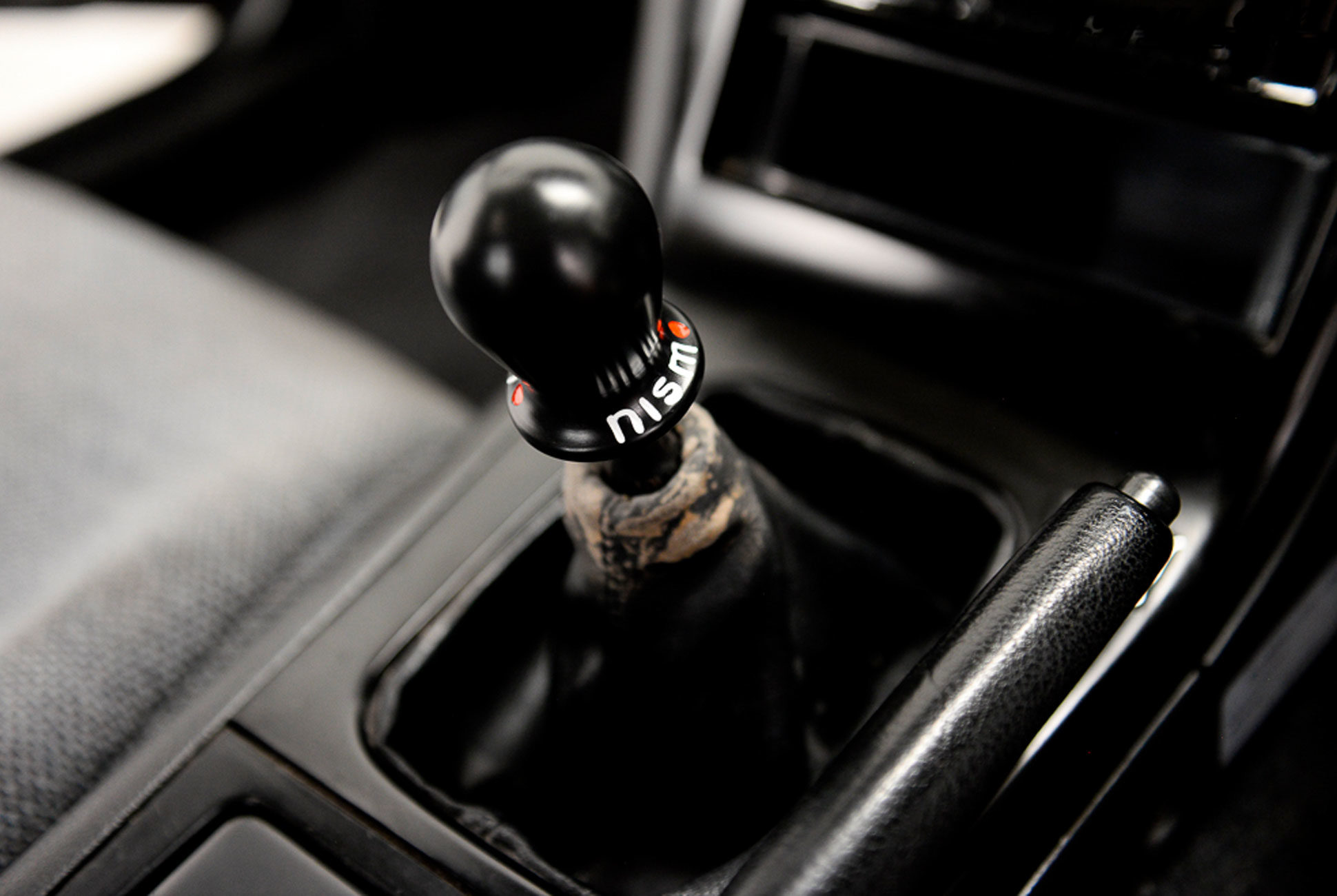

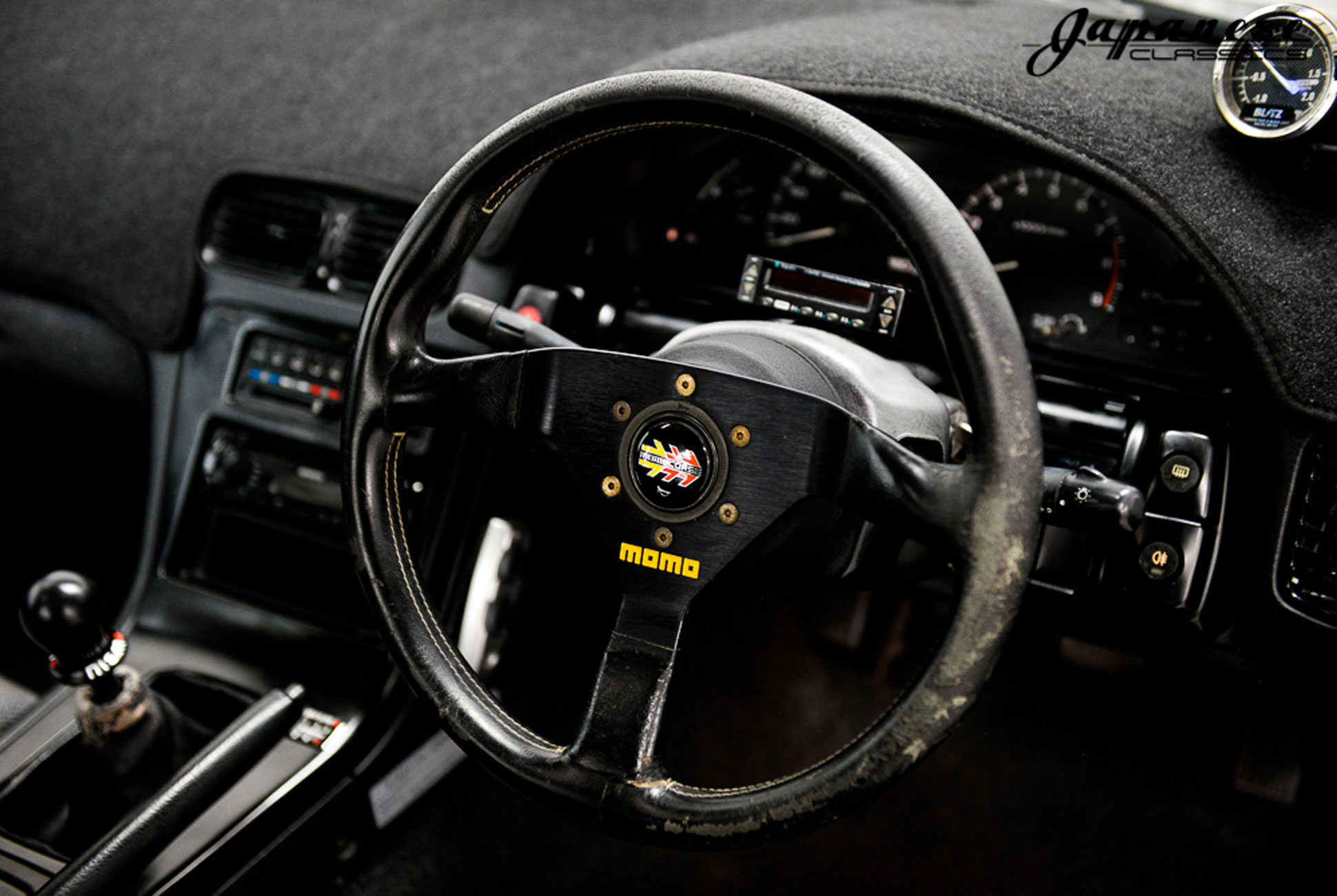
Photos courtesy of Japanese Classics
The website Carwow wanted to see just how the New Porsche 911 Carrera 4S stacks up against the other all-wheel-drive high-end sports cars out there. That meant the company had to stage a serious test, and that led the testers to the drag strip. The company took the new Carrera 4S and put it up against an Audi R8, Nissan GT-R Nismo, and a BMW M850i.
The Porsche 911 Carrera 4S comes with a turbocharged 3.0-liter flat-six engine. That engine produces 443 hp and 391 lb-ft of torque. When compared to the cars it was racing, the Porsche might seem a little outmatched. However, it’s all about how the car can put that power down to the wheels and then transform that into acceleration. The guys doing the video also did a rolling start race and a brake test, which proved just as entertaining as the drag race.
I’m not going to ruin the video results by discussing them here. I will say the results are somewhat surprising. You might not expect to see what happens. Some of the results can be attributed to the drivers, but it really appears that everyone does a good job of driving the cars to their fullest. Check out the video below to see just how impressive all of these cars are.
[embedded content]The wild Nissan GT-R you see here is ready to take on the Jaguar Simola Hillclimb in South Africa in May. The obviously heavily modified car was built by Franco Scribante Racing. The team added, among other things, some of the most outlandish aerodynamic elements to the exterior of the car. Most notably the wings.
The car has a massive front splitter and then an even bigger wing at the front. Then it gets another big wing at the rear of the car. all of this should help smash the car down into the tarmac when it’s at high speeds, which is exactly what the team wants. Carscoops was the first outlet to post a story about the car and Jalopnik dug a little deeper, revealing the vehicle has other changes, too.
It gets upgrades to its 3.8-liter twin-turbo V6 that makes it good for 1,600 hp to the wheels. The team built the car in collaboration with Dodson Motorsport. They went to Pikes Peak last year. This year the team is ready to take on the Jaguar Simola Hillclimb in South Africa. Jalopnik notes the team has been working 18-hour days to prepare for the race.
Celebrations for the half-century of the GT-R started late last year, and have continued throughout the current calendar year. Festivities have come in the form of various homages, the latest Nismo GT-R and most recently, the return of the infamous Bayside Blue colorway – not seen since 2002 – to the current GT-R lineup. While most would argue that ushering in a new generation of the GT-R would have been most serendipitous thing to do, this is still a very thoughtful gift from Nissan.
For longer-term fans of the GT-R, Bayside Blue is unequivocally the most iconic, relatable and classic livery to represent the legendary car. Regardless of one’s palate for hues and saturations, a Bayside Blue GT-R was the undisputed poster boy for the Nissan Skyline (and probably, for Nissan as a whole) in the early 2000s.


At the mere mention of the name, ‘GT-R’, one would be hard pressed not to have a cornucopia of imagery flood their mind – from memories of countless hours spent playing Gran Turismo, or reminiscent recollections of the posters, screensavers or model cars that donned walls, computer screens and display cabinets respectively. And all of it of course, in Bayside Blue.
As has been the case for every year of the R35 GT-R, Nissan has made minor tweaks and performance improvements to the car, and 2020 will be no different in this regard. Such changes include new turbos which increase lower range responsiveness and a modified dual-clutch transmission that allows for quicker gear shifts. The suspension is also said to be the most refined its ever been, while the engine design is now more receptive to aftermarket tuning.
To further commemorate the 50th anniversary of the GT-R, unique interior stitching, special Alcantara accents, one-off badging and a redesigned steering wheel add to the fanfare for 2020 models. While there is no official pricing information yet, we expect the 2020 models to be the most expensive GT-Rs to date (excluding the Nismo).
The 2020 Nissan GT-R Nismo comes with racing-inspired upgrades and a handful of tuning improvements. That means a beastly performance at the very least. The car debuted at the New York International Auto Show in time for the GT-R Heritage’s 50th anniversary.
“Pursuing driving pleasure is the most important concept behind GT-R, and the new NISMO’s performance suggest it is a car that belongs on the race track — but is also at home on the open road.”
That’s Hiroshi Tamura, chief product specialist for the GT-R at Nissan. He says the car has evolved into a balanced yet extreme performance vehicle. For the 2020 GTR-Nismo, specifically, Nissan’s engineers took race-proven technology and made it accessible and comfortable for drivers of all skill levels. To achieve this, they focused on vehicle control and predictability. Which is why they relied heavily “absolute street and track performance” as a theme while developing the car.
Carbon fiber peppered all throughout is hat sets it apart from the rest of the GT-R lineup. You’ll see it on the front and rear bumpers, front fenders, hood, roof, side sill covers, trunk and rear spoiler. Nissan says it improved each component to cut down on weight, increase downforce, and enhance aerodynamics.
In terms of performance, Nissan has upgraded the 600-horsepower GT-R Nismo to the same turbocharger turbine shape as the GT-R GT3. That paves the way for more airflow and acceleration response. Plus a six-speed, dual-clutch transmission, to boot. And let’s not forget the upgraded suspension, evening out power distributed along the wheels.
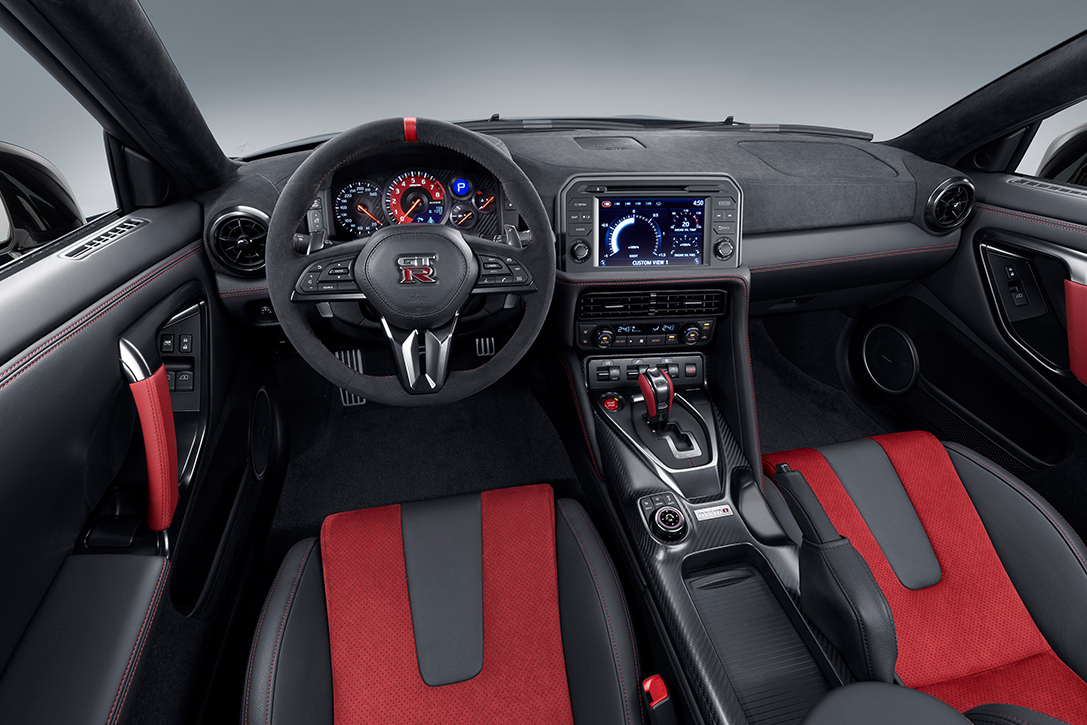
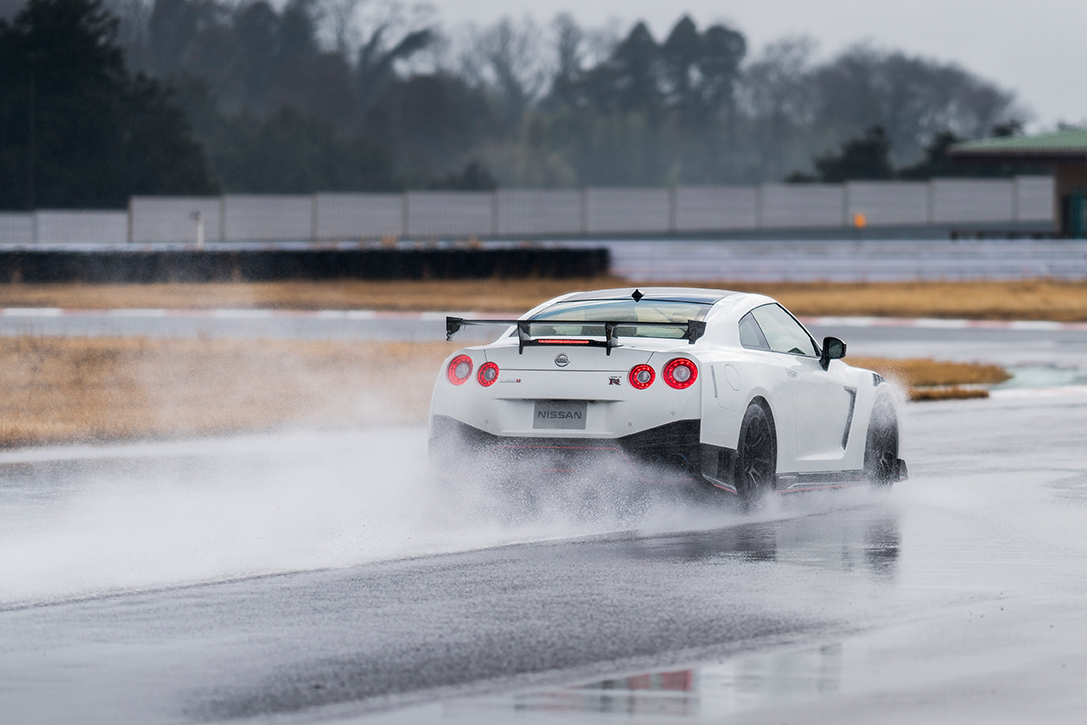

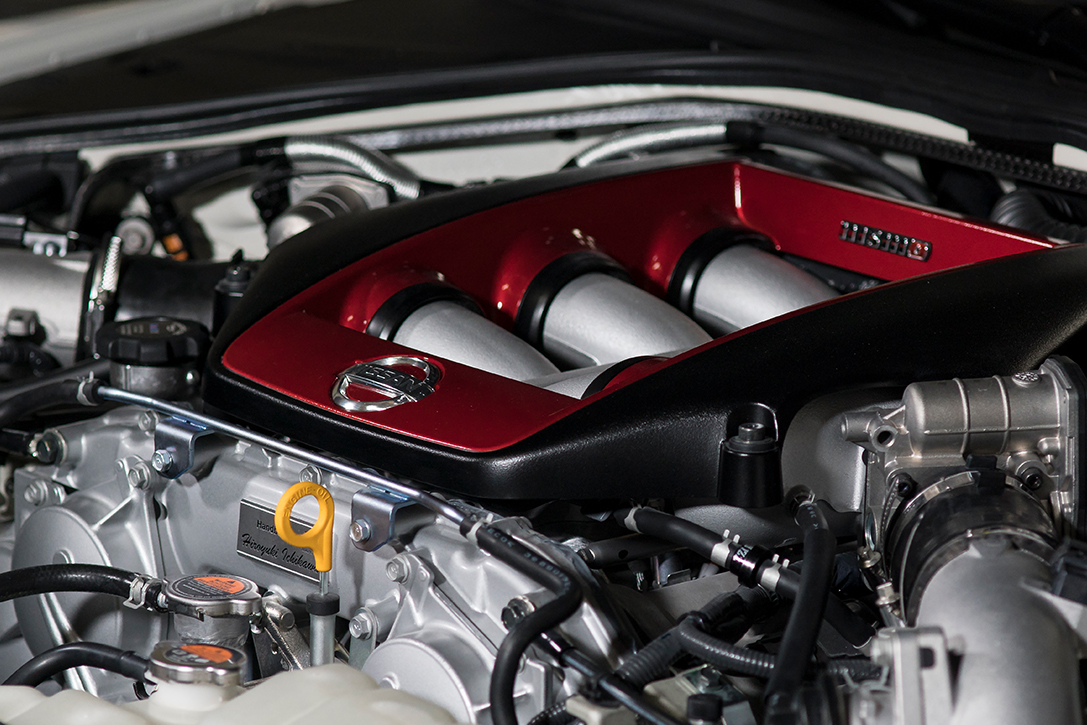

Photos courtesy of Nissan
Walking through the 2019 New York International Auto Show can be overwhelming. With all the shiny sheet metal on display—some of it for the first time—it’s easy to lose yourself in all of the big news and announcements. But, if you take some time and keep your eyes peeled, you’ll see there are a lot of beautiful design details peppered throughout the show’s attractions that you might have missed otherwise. Yes, concept cars will have bucket loads of futuristic moldings and supercars are packed with aerodynamic facets, but even something as mundane as a family sedan can hide an interesting quirk or two.
So, in case you missed them, these are the most beautiful details hidden throughout the cars at NYIAS 2019.
Acura deserves a huge amount of credit for the bold design choices it’s made over the past few years. Acura’s design language is polarizing, to say the least, but if you look closely, you’ll spot intricacies that deserve appreciation. The taillights on the TLX are one of them: They mirror the car’s headlights, making what could’ve been a run-of-the-mill tail lamp into a delightfully complex display.
Open-pore wood isn’t anything new as far as car interiors go, but the Audi E-Tron pulls it off brilliantly. The all-electric SUV is a vision of the future for Audi, and the designers could have gone the usual clinical design route for such things, but it’s nice to see organic material in there instead; it nicely complements the future-forward E-Tron.
There are a lot of details to fawn over on the Genesis Mint concept car, but if one stands out above the rest, it’s the seats. If they look askew in the photo, that’s because when you open the door, they automatically slide back and rotate for easier ingress and egress. And it might only be a concept car for now, but Genesis brand boss Manfred Fitzgerald says he wants to see something like the Mint on the road in the near future.
When autonomous driving takes operational responsibility away from the passengers, the experience of driving as a whole will shift; there will more time to appreciate and interact with the interior, for one thing. Designers are starting to cater to that in concept cars like this funky Kia, by pouring more energy into details like seats and dashboard design. The Kia HabaNiro might look like the crossover of tomorrow on the outside, but the not-so-subtle crimson flair on the inside would be a welcome addition to the Korean automaker’s lineup.
The Koenigsegg Jesko’s rear wing isn’t exactly a “hidden detail,” seeing as how it’s one of the largest objects on the show floor. It helps the Jesko achieve 2,200 pounds of downforce when deployed, but can level out to reduce drag and let the Swedish supercar hit its supposed 300-mph top speed.
Lincoln is quickly becoming a powerhouse in the American luxury car market. It’s very rare an automaker adopts a design language which works on all of its cars, no matter the body style. The Corsair can easily be described as a mini-Navigator, but it also has its own unique details worth a mention. The taillights, for instance, look like the full-width setup Lincoln has applied elsewhere; move in closer and the design begins to resemble a stylized eagle’s wing.
You’ve probably seen the Nissan GT-R50 by now, and drooled over as much as everybody else has. (Just ignore the $1.1 million price tag.) The car was a chance for Italdesign to flex its creative muscles, so it’s packed with design touches. Walk around the back, and you’ll see the semi-floating tail lights that look like jet engines; they compliment the moveable rear wing with its aircraft-like actuators.
Range Rover has been moving towards minimalism for a while, but the new Velar SVAutobiography Dynamic highlights how far the company’s interiors have come—and how well they’re executed.
Nissan came to the New York Auto Show with a reworked Nissan GT-R Nismo, and it looks better than it’s ever been. The car features a new turbocharger setup from the GT-R GT3 car. While the power figures remain the same, this new turbo setup makes the “R” mode of the car much more refined and smooth. The system controlling the throttle response and shift points has been reworked.
In addition to the new turbo, Nissan added a new titanium exhaust and managed to cut out a total of 67 pounds from the car. The company did this by optimizing the carbon fiber components of the car and finding lighter weight parts and components throughout the vehicle.
Nissan also managed to make the GT-R Nismo much more aerodynamic. The company used what it learned from the GT-R GT3 car. The new Nismo features many of the same elements. to make the car more slippery through the air and help pull hot air away from the engine.
Last, but certainly not least, the company reworked the car’s suspension to improve responsiveness. This, in conjunction with some new Brembo brakes, updated Dunlop tires, and stiffer 20-inch wheels from RAYS, help make the GT-R Nismo grip more and perform better than ever before.
Hiroshi Tamura, the chief product specialist for the GT-R, said that the company has made the best street and track car for its customers. “It is about total balance management, not just chasing power figures. The new Nismo has been brought to a new level, with enhanced engine, handling, braking, and aerodynamics.” All of these changes should make the car one of the best on the road or the track. We can’t wait to see one in the flesh or take it out on the racetrack.
No need to buy a fancy expensive-as-hell vintage unit — maybe this 1989 Nissan Skyline R32 will scratch your itch.
On sale at Japanese Classics right now for $16,495, this is the GTS-t Type M, not the 2Gt-R “Godzilla” Skyline 32 that’s more expensive. It’s still a special version, nontheless. We’re talking a turbocharged 2.0-liter inline six engine that draws 212 ponies and 195 pound-feet of torque out of the box. It’s also a rear-wheel drive and weighs just 2,844 pounds. That about puts it near the power-to-weight ratio of another fantastic ride, the Honda S2000, which bid farewell in 2009, unfortunately.
This Skyline R32 comes with a five-speed manual and since it’s japan, don’t be surprised by the right-hand drive. When new, it zooms from zero to 60mph in just 5.9 seconds, which is rather quick for a car out of 1989.
While the Skyline R32 is certainly known for having the most interesting customs, this one is entirely stock underneath the skin, down to the clutch and exhaust. Yup, straight from 1989. The body is still in excellent shape even though it hasn’t been behind glass in ages. Amazingly, it’s still has a factory-spec retractable front splitter.
The downside is that this ride already has 131,000 on the pedometer, but don’t mistake that for weakness. That just means it’s been maintained well after all these years, driven regularly without much issue. And should it err, which it likely won’t, few tears will be shed because of that low price point. Check out the listing on Japanese Classics by hitting the link below.

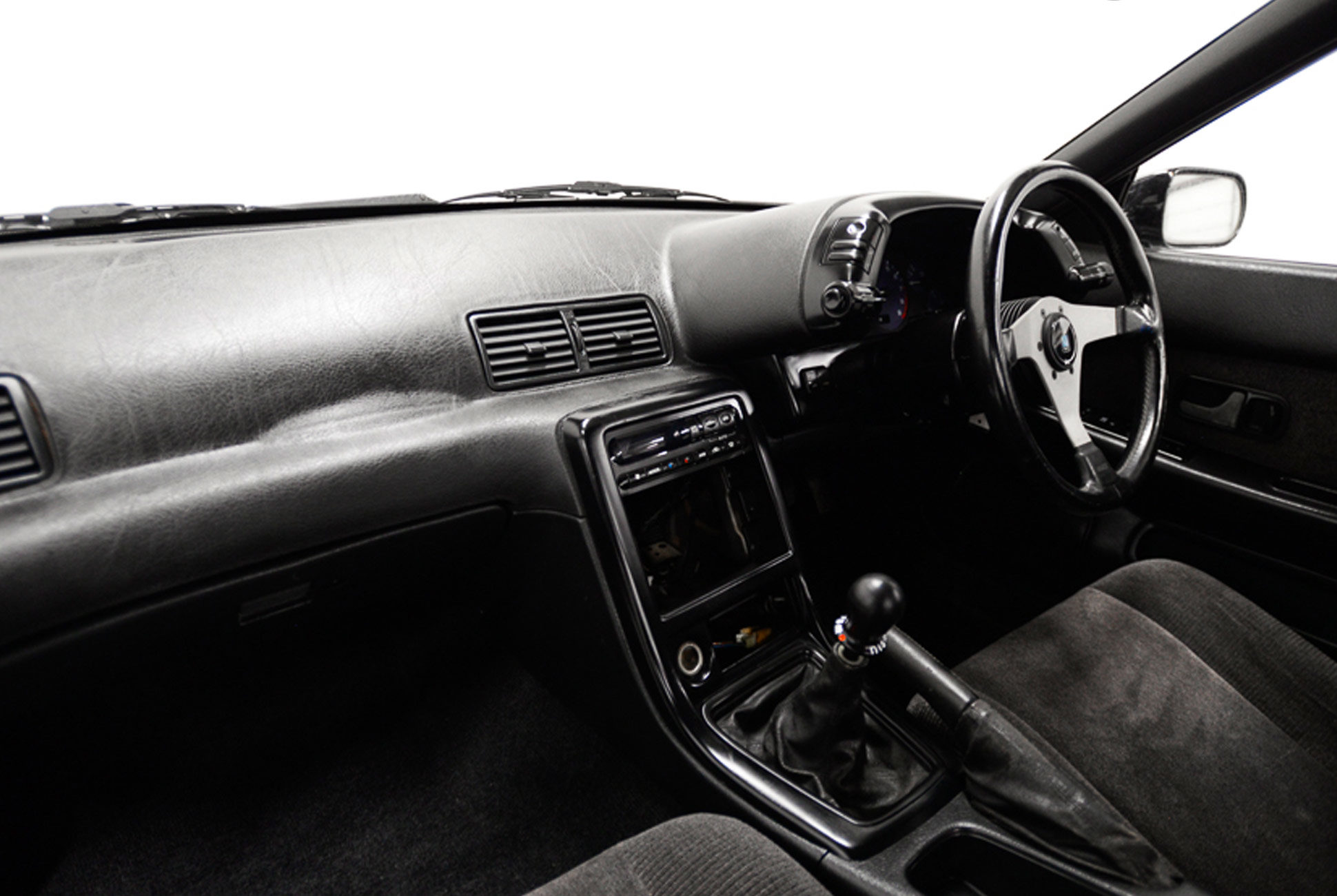


Photos courtesy of Japanese Classics
Nissan is no stranger to out-of-this-world concept cars. It’s unveiled quite a few futuristic auto ideas in the past several years itself. However, its latest, the Dark Sky, is perhaps the coolest yet.
Shown off at the 2018 Hannover Motor Show in Germany, the Dark Sky is a modified European Navara pickup that doubles as a space observatory on wheels. Nissan developed it in collaboration with the European Space Agency (ESA), doubling as a car and a mobile astronomy lab. Dark Sky gives astronomers access to so-called “dark sky” locations that are typically hard to reach.
At the back of the trailer is a PlaneWave telescope that ascends from a mechanized roof. To keep it safe, Nissan included its proprietary ProPilot safety system. That allows users to transport the teleport to more remote locations safely.
The car’s design is very much in line with the cosmos theme, of course. It features a mostly black finish with a white “Nebula” parametric pattern on the body and trailer. The grille boasts red LED lighting accents, and there’s even a LED fog light up top.
In terms of power, a 2.3-liter twin-turbo diesel engine that can produce up to 187 horsepower and 331 pound-feet of torque powers the whole thing.
This concept car demonstrates how a pickup like Navara can support ESA’s star-mapping efforts. It helps astronomers conduct follow-up observations from hard-to-reach locations. Given that Dark Sky is a concept, it won’t go into production anytime soon. However, Nissan vows to donate the telescope “to pass on the spirit of exploration and adventure, and to inspire and educate future generations.”

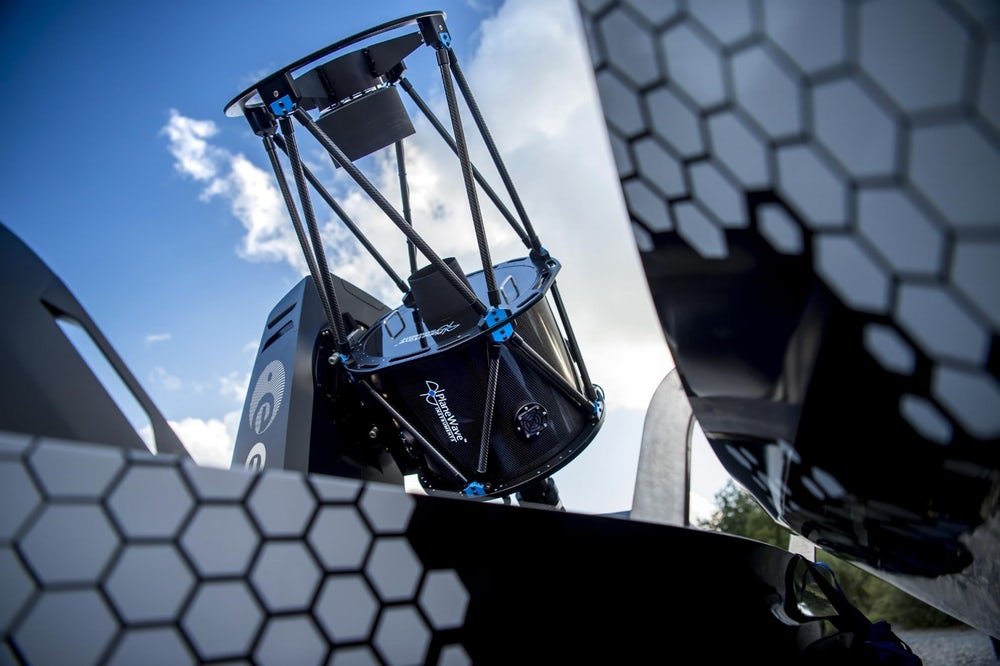

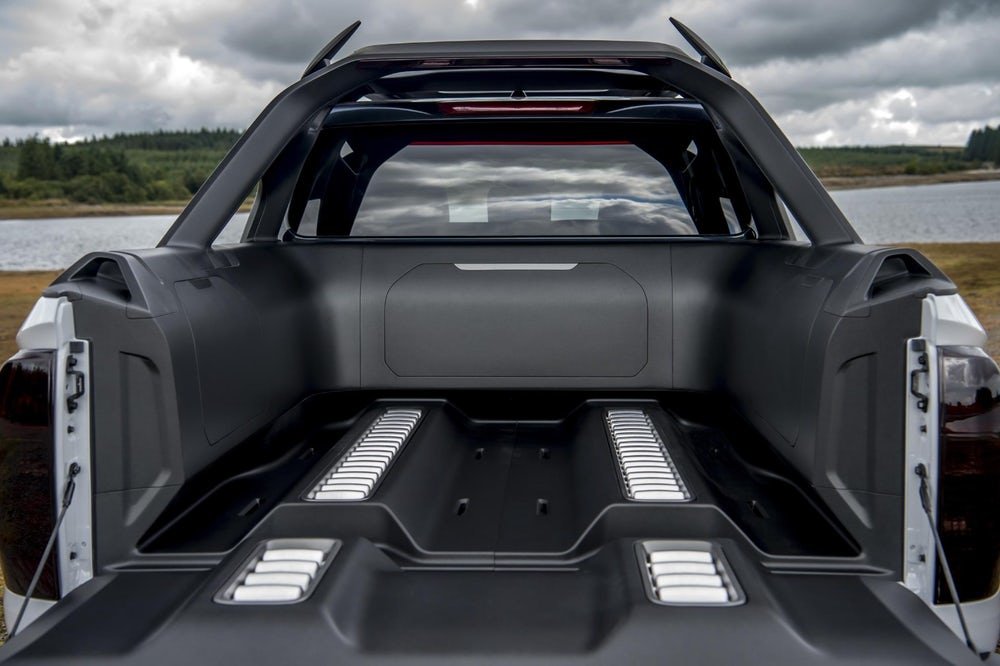

Photos courtesy of Nissan
The Nissan GT-R is still going strong and remains a popular figure amongst supercar enthusiasts. Though it has received some refreshes and minor facelifts along the way, the GT-R (R35) of today continues to be based on the same chassis, engineering principles and overall design cues since its 2009 release.


The 10-year anniversary of the current generation GT-R also coincides with the 50th birthday of the infamous GT-R moniker. It has been a half-century since the first Skyline GT-R was sold through the Nissan Prince Store, foreshadowing what would become one of the most iconic and legendary names in motorsport – ‘GT-R’.
To commemorate this very special time in history, Nissan has teamed up with Italdesign to create a one-off prototype which is based on the top-of-the-line 2018 Nissan GT-R Nismo. Dubbed the “GT-R without limits”, the appropriately named GT-R50 will have a limited production run of just 50 units, each going for $1.05-million USD.


Having already made an appearance at the Goodwood Festival of Speed, the GT-R50 concept will continue its tour with a stop in Belgium at the Spa-Francorchamps circuit, then California’s Pebble Beach and Weathertech Raceway Laguna, before heading home to Japan where final considerations for production will be made.
Nissan has gone on to state that the GT-R50 is not to be thought of as a template for the next generation GT-R – scheduled to be released in 2020 – but as a one-off design which celebrates the heritage of GT-R.
Although the GT-R50 continues to be based on a current production model GT-R, we can expect the Italdesign iteration to be the most unlike any before it. With a re-tuned engine and unique design elements never seen before on the GT-R, it is clear that the collaboration of Nissan and Italdesign treat their proclamation of a “GT-R without limits” as more than just a catchphrase.
Nismo continues its charge in the tuning department, with the familiar 3.8L V6 twin-turbocharged engine now able to produce 710-horsepower and 575 lb-ft of torque, making it the most powerful GT-R ever made from the factory.
This is done by adding larger turbochargers and intercoolers, along with a beefier crankshaft and connecting rods and bearings. Nismo says that they have tweaked the intake and exhaust systems and added larger fuel injectors, oil jets, and revised camshaft profiles.

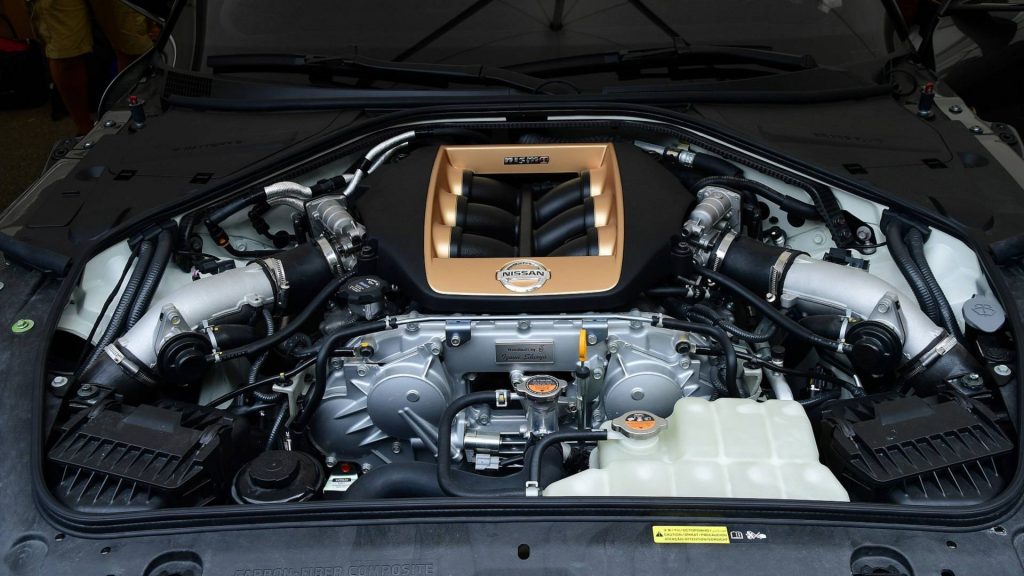
In order to properly acclimatize to its increased power output, the GT-R50 is fitted with a reinforced dual-clutch transmission with sturdier differentials. The GT-R50 has also been equipped with Bilstein Damptronic I suspension with continuously adjustable damping. Brembo brakes and Michelin Super Sport tires mounted to 21” wheels provide the stopping power and grip respectively.
Italdesign’s interpretation of the GT-R50 characteristically saw to it that every body panel on the car would not be left untouched.


Most notable a first glance is the gray and gold contrasting paint job. Included in the plethora of new design cues are a lowered roofline and redesigned rear window, unique front and rear fascias, ‘samurai blade’ front fender cooling outlets, an adjustable rear wing, and reimagined LED headlights and tail lights.

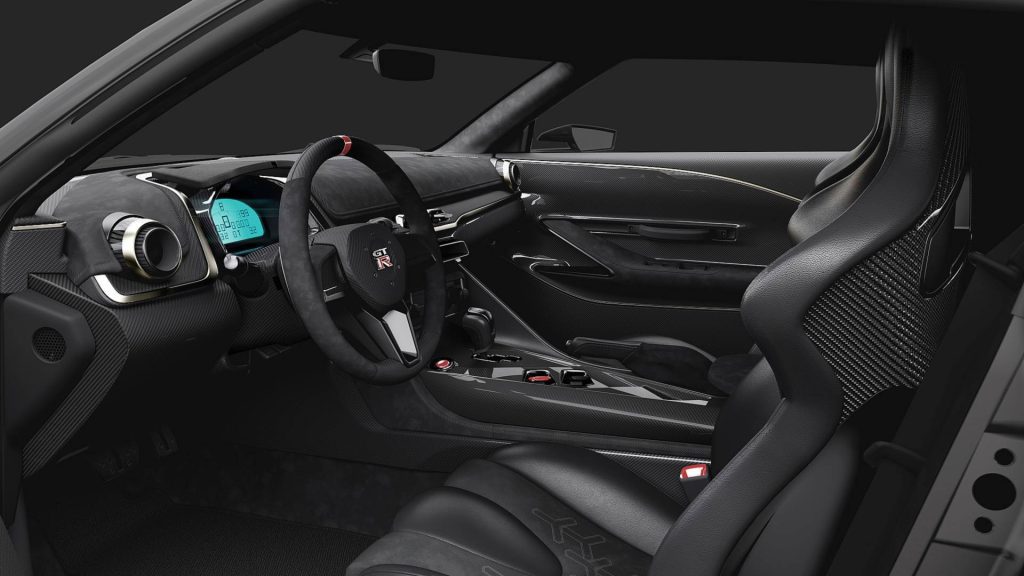
Inside, carbon fiber and Alcantara finishings are used to line the interior. In following with its exterior elements, the interior is also accented with gold colored trim on the digital instrument cluster, door covers, and shift knob.
Here at Supercars.net – in case you haven’t noticed – we love supercars.
That’s why this footage of millions of dollars worth of supercars, classic cars and other precious metal is so painful to watch.
More than 60 luxury and high performance cars and motorbikes were destroyed by Philippine president Rodrigo Duterte as part of an anti-corruption campaign.
The expensive metal had been smuggled into the country illegally in attempts to evade the country’s tax regime that makes buying and importing high value cars prohibitively expensive.
Any car costing more than 2.1 million Philippine Piso (around $39,550) is classified as a luxury vehicle, and hit with a PhP 512,000 tax, plus a further levy of 60% on any amount above PhP 2.1 million.
For something like a base model Porsche 911 Carrera, on sale in the US from $91,100, that would push its cost from the PhP 4.8 million price tag up to PhP 8.25 million – or $155,400 at today’s exchange rate.


If you can’t bear to watch the footage then turn away – in the clip cars sentenced to a crumpled end by bulldozer include a Lamborghini Gallardo, a Porsche 911 Carrera S, a Mercedes-Benz S-Class, Nissan 350Z and a Ford Mustang from what we can see.
[embedded content]And this isn’t the first time Duterte has put on such a public display of automotive destruction in the name of combatting corruption. As the clip below attests, he has form for this kind of thing.
Beware – clip includes graphic footage of a C3 Corvette meeting its end.
[embedded content]The automotive press has spent five years hypothesizing about the next-generation Nissan GT-R, and the prognostications won’t stop soon. Autocar spoke to Nissan head designer Alfonso Albaisa, who revealed that the design team hasn’t yet begun working on the car in earnest because the powertrain isn’t decided. There’ll be a new platform, and there are exterior sketches, but until the internals get locked in, the shell remains a mystery. The most important consideration, Albaisa said, is that the next GT-R be “the fastest super sports car in the world.”
How will the GT-R achieve that? The designer would only say the new coupe would “play the advanced technology game,” adding, though, that said game didn’t necessarily mean hybridization. It’s possible Godzilla could omit an electric motor. However, we’d be shocked if that happened when the primary competition — the Porsche 911 and even the C8 Chevrolet Corvette — have hybrid options planned or rumored over the lifecycles of their next-gen models, and super sports cars like Lamborghini and Ferrari are already confirmed for hybrid conversion.
Years ago, during the dark days of the LMP1 GT-R LM NISMO, sabers rattled about the next GT-R getting some version of the 3.0-liter V6 in the race car, and assumed electric assistance. Former Nissan EVP Andy Palmer said there was the “very real prospect of enhancements coming from [the race car] and ending up on a sports car like the Nissan GT-R,” and, “I’d expect to see some form of hybridization on the next generation of car.” The design would be a toned-down version of the 2020 Vision Gran Turismo, and power would stand at around 786 horsepower and 737 pound-feet of torque, shifting through a new eight-speed dual-clutch. But the race car died an awful death, Palmer’s now the head man at Aston Martin, and the Vision Gran Turismo never left the video game.
Even more confounding, Albaisa’s comments make it sound like the new GT-R might need to overcome its own bodywork on its way to being “the quickest car of its kind” and owning the track. The new coupe won’t shrink from its heavyweight stance, with Albaisa saying the visual mass and “audacity” will need to communicate that “It’s an animal; it has to be imposing and excessive.” We should expect a cohesive design that does its aero work without a lot of extra appendages. Said the designer, “It’s the world’s fastest brick, really. And when I review sketches for the new car, I say that a lot: ‘Less wing, more brick.'”
A 2016 report from Autoevolution ties into Albaisa’s comments. We were told not to expect major weight loss, with GT-R father-figure Kazutoshi Mizuno suggesting in interviews that the coupe’s corpulence “ensures a correct level of handling for all customers.”
So all we think we know now is that we’ll get 2+2 seating, a twin-turbo V6 in front, a transaxle layout, and an all-wheel-drive powertrain. And based on this latest insight, and what the competition’s doing, we can probably expect a healthy price increase for the standard model whenever it finally gets here.
Related Video:
Coming to the Monterey Auction on August 24 is an exceptionally rare example of one of Japan’s first homologated sports cars–the 1972 Nissan Fairlady 240ZG.
The 240ZG is a legend in Japan thanks to its 1972 Fuji Grand Champion Series win, among other races. With its striking long hood and short tail proportions, the car is said to be highly appreciated for its balanced handling and torquey engine.
Believed to be one of only a handful in the US, the factory-original JDM unicorn you see here is powered by an inline-6 cylinder with a cast iron block, producing 151-hp. Race-oriented features include independent front & rear suspension, riveted fender flares, a rear spoiler that reduces lift at high speeds, aerodynamic headlight covers, and fender-mounted rear-view mirrors.
Recently refurbished (including the paintwork in a glorious Grande Prix Maroon original shade), this exceptional vehicle arrives with the original black vinyl interior, Datsun racing steering wheel, and even a period-correct Nissan AM radio fitted low on the dashboard.







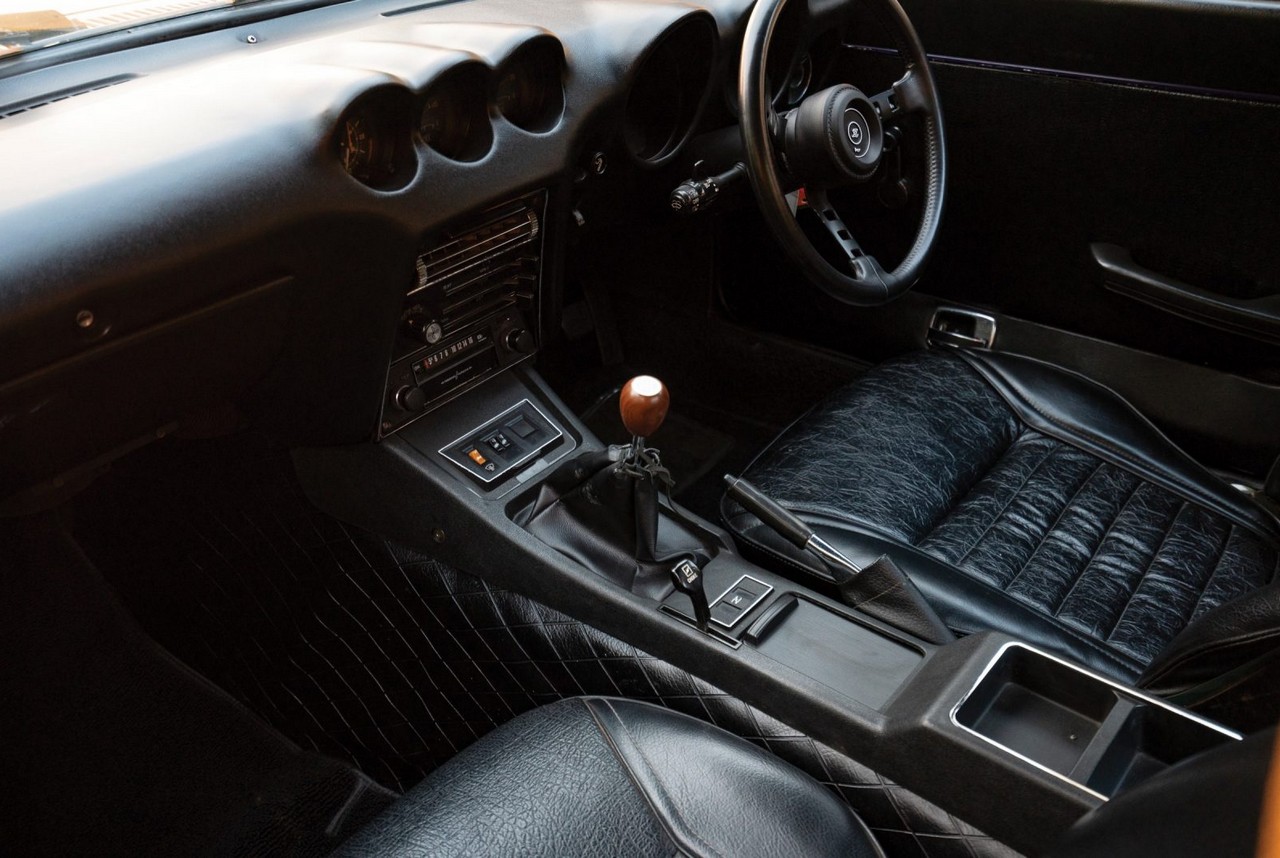
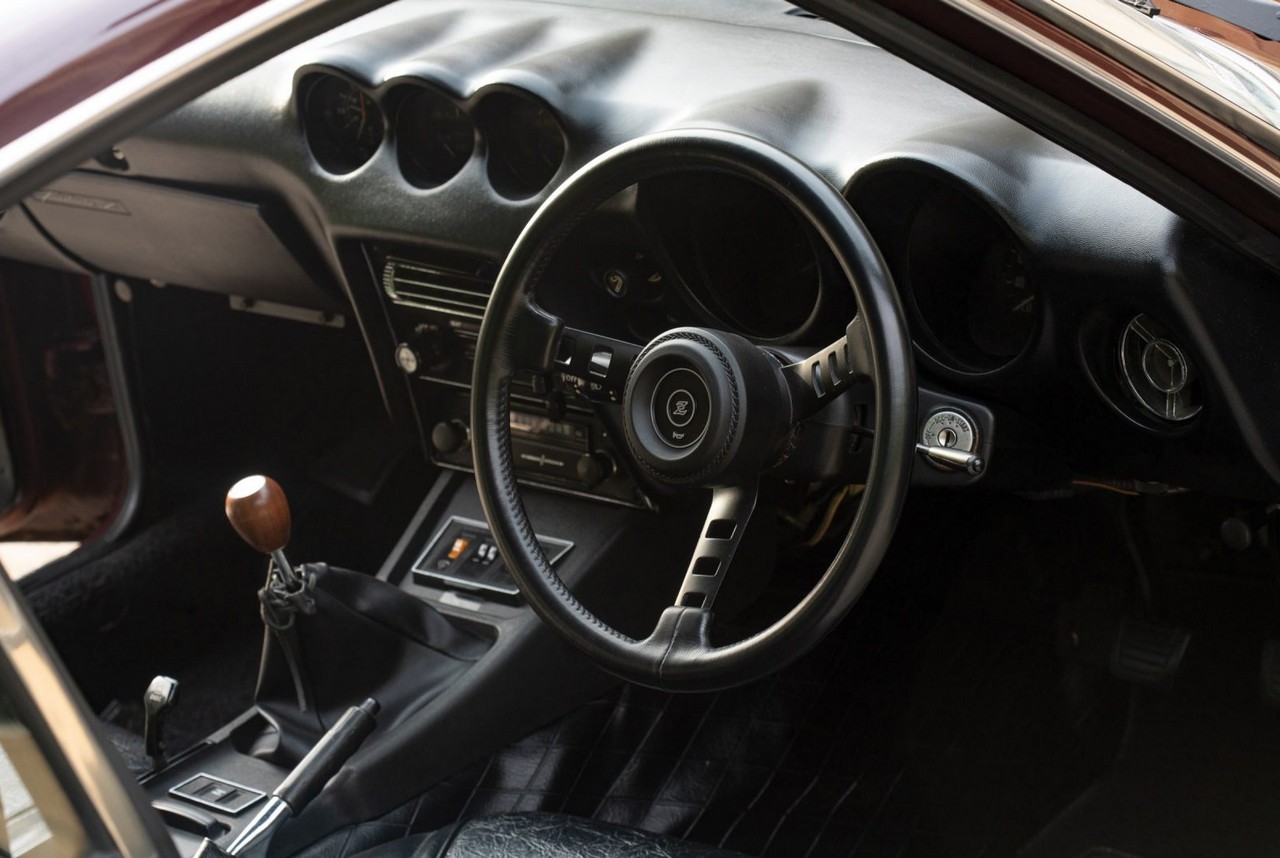
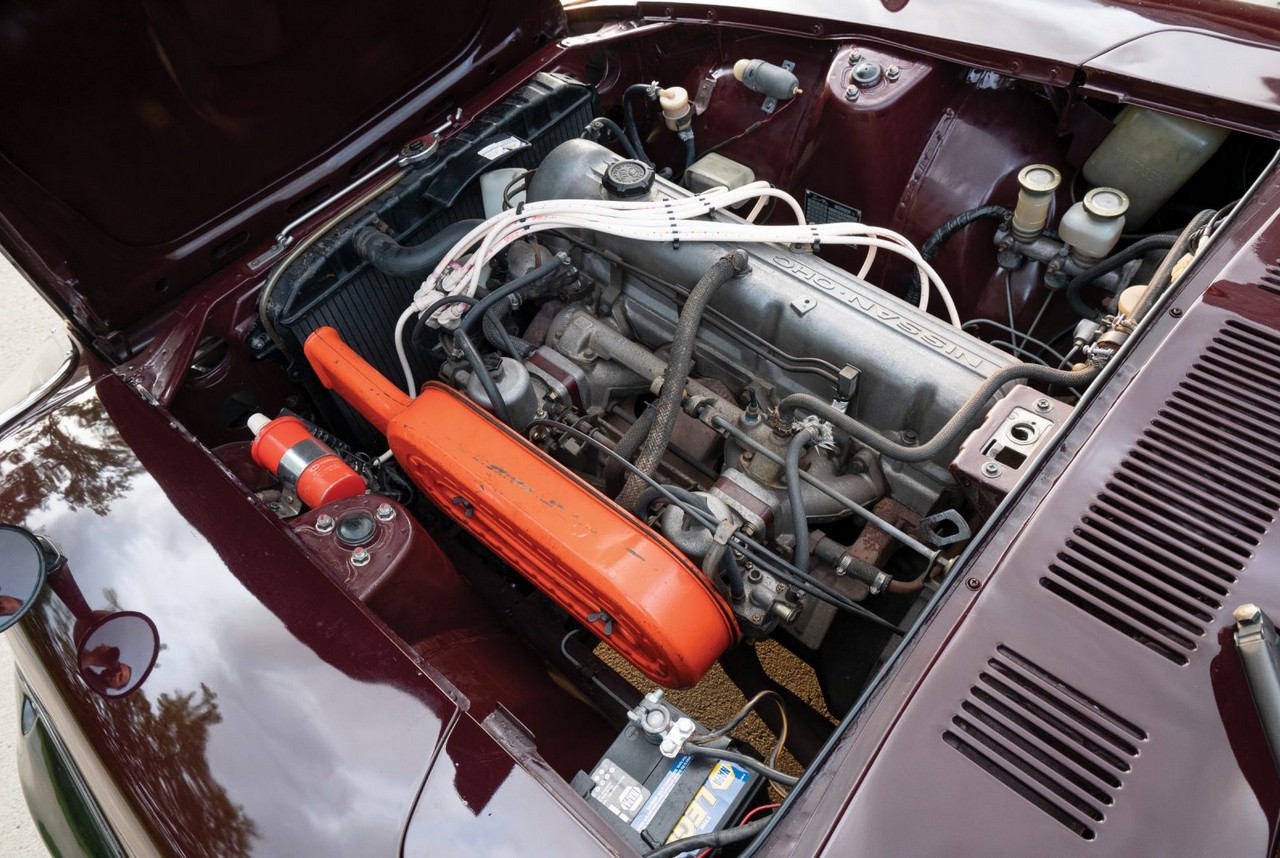

 Photos Courtesy of RM Sotheby’s
Photos Courtesy of RM Sotheby’s